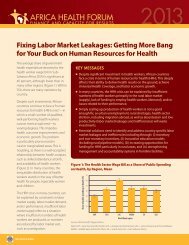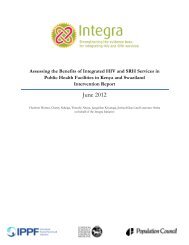ujh78
ujh78
ujh78
Create successful ePaper yourself
Turn your PDF publications into a flip-book with our unique Google optimized e-Paper software.
children who had dropped out of school was 3 percentage points higher for males (10%) than for females<br />
(7%) (see Table 6.5).<br />
We found geographic disparities of at least six percentage points in the percentage of children<br />
who had dropped out of school in Burkina Faso (urban: 13% and rural: 21%) and Madagascar (urban: 9%<br />
and rural: 15%). We found smaller discrepancies, three to four percentage points, in Mali (urban: 5% and<br />
rural: 9%), Democratic Republic of Congo (urban: 7% and rural: 11%), and Zimbabwe (urban: 5% and<br />
rural: 9%) (see Figure 6.13 and Table 6.5).<br />
The role of the household head’s sex and age<br />
Overall, there was no association between the sex of the household head and major differences in<br />
the percentage of children who dropped out of school (see Figure 6.14). In Burkina Faso children in a<br />
household whose head was age 50 or older were over five percentage points more likely to have dropped<br />
out than children in households headed by a younger person (24% versus 17%) (see Table 6.5).<br />
Variations during the last 13 years<br />
Reductions of at least six percentage points in the percentage of children age 7-17 years who<br />
dropped out school took place only in Benin (2001: 20% and 2006: 14%), Ghana (2003: 14% and 2008:<br />
7%), Kenya (2003: 11% and 2008-09: 4%), and Zambia (2001-02: 20% and 2007: 9%) (see Table 6.3 and<br />
Figure 6.16).<br />
110








